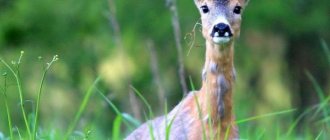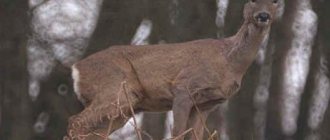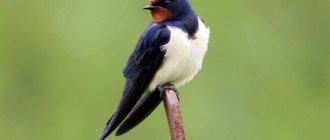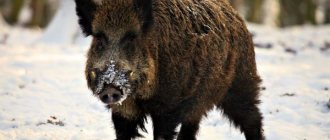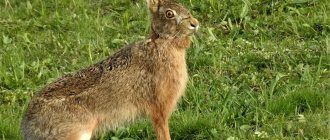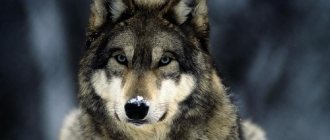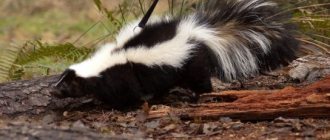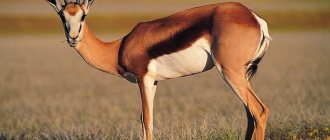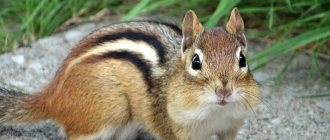The roe deer is an animal from the class Mammals, subclass Animals, infraclass Placentals, superorder Laurasiotherium, order Artiodactyla, suborder Ruminant, family Deer, genus Roe deer (lat. Capreolus). This article will discuss this genus.
International scientific name : Capreolus Gray, 1821
Synonyms of the genus:
- Capreolus Frisch, 1775
- Caprea Ogilby, 1837
English names : Roe, Roe deer
German names : Reh, Rehwild, Ricke
These animals received their name (both in Russian and in Latin) due to their external resemblance to goats (in Siberia, roe deer are still called “wild goats” and “roes”, and their Latin name directly goes back to Capra – goat). However, regarding the Russian-language name of the name, there is such a version that the roe deer received it due to its slanted pupils.
Photo credit: Frank Vassen, CC BY 2.0
Roe deer: photo, description, characteristics, what it looks like
Roe deer are small and slender representatives of the Deer family. Their body length ranges from 100 to 150 cm, the height of the animals at the withers varies from 66 to 94 cm. The tail is short, from 2 to 4 cm in length. The average weight of a roe deer ranges from 21 to 60 kg.
The European roe deer is smaller than the Siberian, its body size is usually 100-135 cm, height 66-81 cm, body weight from 20 to 37 kg. The length of the Siberian roe deer reaches 150 cm, and an adult animal weighs up to 60 kg. Sexual dimorphism in both species is weak, with the male on average only slightly larger than the female.
Photo credit: Klaus Rassinger and Gerhard Cammerer, CC BY-SA 3.0
The head of a roe deer looks as if it is shortened; in the males, in the spring-summer-autumn period, it bears antlers of light or dark brown color. They are small in size (up to 33 cm in length), the number of processes is from 3 to 6. The trunks of the horns are usually parallel to each other (in the European roe deer), or noticeably diverge to the sides (in the Siberian roe deer). The span of the horns is from 10 cm (in the European roe deer) to 47 cm (in the Siberian roe deer).
At the base, the horns have rosette extensions with well-defined tubercles (otherwise known as pearls). Roe deer shed their antlers in the fall, in September-October; while new ones begin to grow almost immediately after the old ones are shed, usually in December. The horns grow completely by May-June. Although horns begin to develop already in males of the year (usually growth in the first year of life begins in August, but by December these horns are already shed), full-fledged horns with processes develop in males only starting from the third year of life. The horns are used by roe deer males for fights with other males: for the female during the mating season and for the territory (since roe deer are territorial animals) in the spring-summer-autumn period.
Female roe deer usually do not have horns, but in some cases a female may develop one, two or even more ugly short horns.
Photo credit: Joachim Bäcker, CC0
The animals' eyes are quite large. The jaws are relatively short. There are 32 teeth in the mouth of a roe deer, with incisors (6) and canines (2) only on the lower jaw, and premolars and molars - 6 each on both the upper and lower jaws.
The ears of roe deer are long, oval, noticeably pointed at the end, reaching 13 cm in length.
Photo credit: Amanda 77, CC BY-SA 3.0
The neck of a roe deer is long, there is no mane, but the body is relatively short. The front legs are somewhat shorter than the hind legs, which, among other things, indicates a tendency to move by jumping.
Each leg has four hooves, dark brown, almost black; middle (2nd and 3rd) support, narrow and sharp. The side hooves are small and never touch the ground.
Photo credit: Joachim Bäcker, Public Domain
The color of roe deer in winter is gray or grayish-brown, in summer it is brighter, reddish-red. Roe deer cubs are spotted.
Roe deer have a near-tail “mirror” - a large light patch of hair under the tail, which serves as a means of communication, mainly as a “follow me” signal. The individual who was the first to notice the danger and began to run away shows this bright spot to the rest of the individuals in the herd and thus transmits an alarm signal to them. The size of the tail mirror of a roe deer varies depending on the season: in winter it is large and bright white, in summer it is smaller and darker, and in some individuals it is not expressed at all. This is quite understandable - it is in winter that roe deer gather in herds and herds of varying numbers, where this means of communication is required; In summer, roe deer lead a solitary lifestyle and there is simply no one for them to give signals with a “mirror”.
Photo credit: xulescu_g, CC BY-SA 2.0
There is often a light spot on the throat and chin of roe deer. There is a dark spot on the lower lip.
The edges of the upper lip are often white, while the lip itself and the circumference of the nose are dark, black or brown, vaguely reminiscent of a mustache in shape. The male roe deer is no different in color from the female.
Photo credit: KoitR, CC BY-SA 3.0
Roe deer shed twice a year, i.e. They have both spring (in April-May) and autumn (in August-September) molt. However, it should be borne in mind that females and yearling calves can wear summer fur until October.
The “summer” fur of roe deer is somewhat shorter (about 3-3.5 cm), the “winter” one is correspondingly longer (5-5.5 cm) and more brittle than the “summer” one.
Photo credit: Marek Szczepanek, CC BY-SA 4.0
When escaping from predators, a roe deer can reach a maximum speed of up to 60 km/h, although it can run like this for no more than 5-6 minutes. In this case, the running animal moves in jumps of 4-5 meters, and if necessary, can jump over an obstacle (a hole or stream) up to 8 meters in length. When running fast, the roe deer jumps up 2-2.5 meters from time to time: see if the pursuer has fallen behind.
When large rivers come across roe deer, the animals easily swim across them. Thus, herds of Siberian roe deer during migrations are safely transported across rivers such as the Yenisei or Amur.
The vision of roe deer has the same features as other deer. The eyes, widely spaced on the sides, do not provide binocular vision (not really necessary for ungulates), but they do provide a wide viewing angle. True, it has been repeatedly noted that if a roe deer sees moving objects well, then, for example, it may not notice a motionless hidden person, unless other senses - hearing and smell - signal its presence.
Photo credit: Vera Buhl, CC BY-SA 3.0
The hearing of roe deer is very well developed (as evidenced by its large and very mobile ears). The sense of smell is even better developed, which not only allows you to timely notice predators or rivals, but also in winter to find food under the snow cover.
Description of the animal
The roe deer is a small, graceful animal with a short body and a thinner and lower front part compared to the back. On average, the weight of a male does not exceed thirty-two kilograms. With a body length of about one hundred and twenty-five centimeters, the height at the withers is no more than eighty centimeters. Females are slightly smaller, but, as a rule, do not differ much in appearance from males.
The head of a roe deer is short, gradually tapering from the ears to the nose. The ears are oblong and slightly pointed at the ends. The eyes are large and slightly protruding. The neck is long and muscular. The legs are slender, with the hind legs longer than the front ones. They have small hooves. The tail is very small. The head of male roe deer is decorated with small branched horns that grow almost vertically. Their length ranges from fifteen to thirty centimeters, and their span does not exceed fifteen centimeters. The horns have three branches, with the middle branch slightly inclined forward.
The cubs' horns appear in the fourth month of life, but are fully developed only by the age of three. Females do not have horns.
How does a roe deer scream?
People call the cry of roe deer differently, using the words "bark", "roar" or "squeak". Indeed, the voice of roe deer is quite unique. Most often, animals make sounds that resemble the hoarse bark of a dog. This is usually an alarm signal intended for other roe deer. However, males during the mating season (during the rut) make similar barking sounds, accompanying them with something like a loud squeal. In addition, adult females, when calling their cubs, make loud whistling sounds without opening their mouths.
Photo credit: Alexic Arsac, CC BY-SA 4.0
What does a roe deer eat in the wild?
The roe deer is an exclusively herbivorous animal. Her diet includes various herbs. If given a choice, roe deer most readily eat legumes, hogweed, clover, buttercup, fireweed, yarrow, and in the spring, cereal plants, including winter wheat, rye, barley, and wheatgrass. Also, the roe deer's food is foliage and young tree shoots, of which the mammal prefers aspen, willow, rowan, and linden. Roe deer loves various wild berries (viburnum, rowan, lingonberry, etc.). In addition, in the fall, roe deer can eat small quantities of mushrooms (birch sponge, deer spittle, etc.), and in winter they can feed on lichens (deer cladonia, forest cladonia, Icelandic cetraria, etc.). In the Primorsky Territory, these animals eat algae on the seashore. In winter, roe deer most eagerly feed on winter-green plants (i.e. those that overwinter under the snow with lush green leaves and shoots that do not dry out) - such as horsetails, blackberry and ivy leaves.
In the warm season, the diet of roe deer does not consist of all plant foods in a row - the animal selectively plucks certain parts of plants: inflorescences and infructescences in grasses, young leaves and twigs in trees and shrubs. In winter, when there is little food and high energy costs, the roe deer eats the grass completely, digging snow to the ground to do this. In shrubs and trees in winter, animals eat young branches, buds and dry leaves.
Photo credit: SwedishDjur, CC BY-SA 4.0
In summer, roe deer graze in the mornings, evenings and at night (usually in the first half), and during the day, when it is hot, they hide in grassy vegetation or under trees. In winter, they can feed at any time of the day. Only if heavy snowfall or a blizzard begins do the animals hide in the thicket of the forest, sheltering from the weather.
Roe deer are able to go without water for a long time and live far from water bodies, but then the role of moisture absorbed with food increases (one of the reasons why roe deer feed mainly in the morning and evening in the summer is dew that settles on plants at this time). If the pond is located near feeding areas, animals visit it regularly. The role of moisture-containing food increases especially in winter. During the winter period, the death of roe deer from dehydration was repeatedly observed, despite the fact that their stomach was full of food. Snow, even if present, cannot serve as a source of moisture for a long time, since it takes too much energy to melt it in the animal’s body.
Photo credit: ITz Marco465, CC BY-SA 4.0
Roe deer habitats
Very often you can encounter these animals in areas of deciduous and coniferous forests, as well as in river valleys and reed thickets. As for deciduous and coniferous forests, roe deer are most often found in open forests.
Animals are always searching for food from sunrise to sunset. As for the rest of the time, the roe deer are in their bedding areas.
Even in winter, just like in summer, these animals do not sit in one place. They prefer to organize bedding areas in different places. So, for example, in summer the most ideal place for lying down is ordinary bushes and even tall grass. In the winter season, animals use an ordinary pit for these purposes. At the same time, this place must be sheltered from the wind.
In summer, roe deer feed on ordinary grass, as well as berries and juicy fruits. In the winter season, it is much more difficult for these animals to find food. Therefore, these mammals spend most of the very short winter day searching for food.
During the cold season, animals feast exclusively on those found under the snow cover:
- acorns;
- mosses;
- dry herbs;
- shoots;
- buds of trees and shrubs.
Where does the roe deer live?
Roe deer live in Eurasia:
- The European roe deer lives throughout Europe, including the UK, Scandinavian countries and European Russia, as well as in the Caucasus. In addition, it is found in Transcaucasia (Azerbaijan, northern Georgia, northern Iran, and, according to some sources, in Turkey).
- The Siberian roe deer lives in the east of the European part of Russia, as well as in the south of Siberia and the south of the Far East. In addition, it is found in Mongolia, northern China, North Korea and northern Kazakhstan.
In Russia, roe deer are found in 62 regions: Belgorod, Bryansk, Vladimir, Voronezh, Kaluga, Kursk, Lipetsk, Moscow, Oryol, Ryazan, Smolensk, Tambov, Tver, Tula, Kaliningrad, Leningrad, Novgorod, Pskov, Astrakhan, Volgograd, Rostov, Nizhny Novgorod, Orenburg, Penza, Samara, Saratov, Ulyanovsk, Kurgan, Sverdlovsk, Tyumen, Chelyabinsk, Irkutsk, Kemerovo, Novosibirsk, Omsk, Tomsk, Amur regions, Republic of Dagestan, Rep. Ingushetia, Kabardino-Balkarian Republic, Karachay-Cherkess Republic, Rep. North Ossetia-Alania, Chechen Republic, Stavropol Territory, Republic. Adygea, Krasnodar region, Rep. Bashkortostan, Rep. Mordovia, Rep. Tatarstan, Udmurt Republic, Chuvash Republic, Rep. Altai, Rep. Buryatia, Rep. Tyva, Rep. Khakassia, Altai Territory, Transbaikal Territory, Krasnoyarsk Territory, Rep. Sakha (Yakutia), Primorsky Territory, Khabarovsk Territory, Jewish Autonomous Region.
The western border of the distribution of the European roe deer is the state border from the Baltic to the Black Sea; from the north, the border of distribution of this animal in Russia goes from the Gulf of Finland to Kandalaksha, Petrozavodsk, Tikhvin, Vyshny Volochek, Tver, Zagorsk, Kolomna and Ryazan. In the Volgograd region east of Khopr, the border of the range runs along the Don to the west to the Sea of Azov. In the Ciscaucasia, the border of distribution of roe deer in Russia goes from Yeisk south of Kuban through Nevinnomyssk, Grozny, Kizlyar and Makhachkala. From the south, the Russian part of the Caucasian roe deer range coincides with the Russian state border.
This is what the tracks of a roe deer look like. Photo by: Tomasz Kuran aka Meteor2017, CC BY 2.5
The range of the Siberian roe deer is even more extensive. In the west, its border is the Kirov-Cheboksary-Saransk-Penza-Balashov-Povorino line, then the Khoper and Don rivers to Volgodonsk. Here it is closely adjacent to the range of the European roe deer, and in some places overlaps with it, which periodically leads to hybridization of these two species. The southern border of the range runs from Volgodonsk east to the state border, and then along it to the Pacific Ocean. The northern border of the range of the Siberian roe deer goes from Kirov along Vyatka and Kama, then along the border of Bashkiria and the Perm region to Nizhny Tagil, from there to Tyumen, then to Tara, from there to the mouth of the Angara. Along the right bank of the Angara it reaches the Bratsk Reservoir, bending around it from the north, then goes south along the Baikal and Primorsky ridges, abutting the Eastern Sayan. In Yakutia, the distribution of roe deer is limited to the Lena Plateau - in the north, the range is limited to areas of the Central Yakut Lowland, where a lot of snow falls, and in the south - to mountain ranges. In the Far East, the northern border is limited by the Stanovoy Highlands and the Stanovoy Range, along which it reaches the upper reaches of the Uda River, and then passes along the Dzhagdy, Bureinsky, Badzhalsky and Sikhote-Alin mountain ranges. Along the eastern slopes of the Sikhote-Alin, the border of the Siberian roe deer range reaches the Botchi River.
Roe deer (both European and Siberian) are originally an inhabitant of forest-steppes. It is in this natural area that she feels most comfortable. However, people, developing the forest-steppe, gradually pushed the roe deer into the forests. However, roe deer cannot live in all forests. They avoid dark coniferous taiga, preferring deciduous forests (the distribution of which largely determines the boundaries of the roe deer's range). In the steppe zone (in particular, in the Ciscaucasia), the habitat of roe deer is also confined to natural or artificial forests or shelter belts. In open steppes, where trees are completely absent, roe deer are not found.
Some populations of Siberian roe deer migrate in winter, moving to more southern and less snowy regions (a snow cover height of 30 cm is already critical for roe deer). The distance covered by migrating animals from calving grounds to wintering grounds reaches over 100 km.
Photo credit: PeterRohrbeck, CC BY-SA 4.0
Lifestyle
In summer, roe deer are active in the morning, evening and night. In winter, they are predominantly diurnal, but can be active around the clock.
In the warm season, roe deer live alone, except for females, accompanied by yearling calves. During the mating season, temporary pairs of animals appear. In October, the animals, previously living alone, unite into small herds, the basis of which are family groups, and remain in such herds until spring. Herds often unite into large herds of up to hundreds of individuals. It happens that in these herds there are from several to several dozen males, which in the winter peacefully coexist next to each other, while in the summer (while they live alone) they are exclusively aggressive towards other males.
In winter, large groups of roe deer most often form in feeding areas in order to detect danger in a timely manner. The roe deer is a cautious animal, so the more individuals there are in the herd, the sooner one of them will notice the predator. The sight of a running individual immediately provokes other roe deer to flee after it. The composition of large herds is not constant - when fleeing from danger, such a herd easily breaks up into family groups and then forms in a different composition.
Photo credit: Gouwenaar, CC BY-SA 3.0
Hunting from ambush
They hunt using this method on bait sites using two methods that have more similarities than differences. In the first case, the hunter guards the target on an equipped tower. In the second, the waiting place is a hastily arranged ambush. The latter is most often installed on paths made by animals in a snowy forest.
Hunting farms that have their own lands equip towers, taking care of the shooters. Their construction is very durable and they are equipped with comfortable seats inside. To protect hunters from cold nights, they are heated. There are loopholes for shooting. To avoid spooking the roe deer with random noise, the opening windows are lined with felt.
Placing a regularly updated feeding area under the tower is a guarantee of successful hunting. Over time, the animal perceives the constructed structure as a natural part of the surrounding landscape, and therefore does not experience fear when approaching it.
Equipped tower for hunting
Ambush hunting is more difficult not only because of the wait in sub-zero temperatures. It is also necessary to observe the animal in order to determine the location of the ambush. At the same time, it should fit into the landscape of the forest, and not attract the attention of the roe deer with its unnatural appearance. Using scrap materials will avoid this.
Additional difficulties during such a hunt are caused by the animal’s highly developed ability to smell a person hiding in a hideout. It is forbidden to change the ambush site at night. There may be other hunters in the forest who, due to the darkness, are able to mistake you for a very large and dangerous predator and shoot.
This method of hunting is considered the easiest, because the animal itself goes to meet the hunter.
Types of roe deer, names and photos
Below is a description of both varieties.
- Capreolus сapreolus (Linnaeus, 1758) – European roe deer, roe deer, roe deer, wild goat
The smallest species of the genus. The winter color is gray or grayish-brown, the summer color is reddish-red. The “mirror” is well defined in winter and barely noticeable in summer. Males' horns usually have three branches. The body length of the European roe deer is usually from 100 to 135 cm, the height at the withers is 66-81 cm, and the animal weighs from 20 to 37 kg.
The European roe deer lives in Europe (including Great Britain and Scandinavia), except for. Sicily, in the European part of Russia, in the Caucasus, Transcaucasia and Western Asia. Prefers to settle in forests interspersed with open spaces, fields, etc. Thanks to such habitat preferences, it is able to coexist well with humans in agricultural landscapes (unlike most other ungulates).
Photo credit: Przykuta, CC BY-SA 3.0
- Capreolus p ygargus ( Pallas, 1771) – Siberian roe deer
The largest species of the genus. The color of the fur does not differ from the European roe deer. The antlers of male Siberian roe deer usually have 3-6 branches. Body length reaches from 124 to 150 cm, height at withers 75-90 cm, body weight from 32 to 60 kg.
Siberian roe deer live in the east of European Russia, in the south of Siberia and the Far East, in China, North Korea and Central Asia. Like the European, the Siberian roe deer prefers the following natural zones: forests alternating with open spaces, forest-steppes, and also lives in deciduous forests. Avoids dark coniferous taiga.
Photo by: Svetlana Guryeva, CC BY-SA 4.0
Hybrids
The existence of hybrids of European and Siberian roe deer in natural conditions - where their ranges overlap in the European part of Russia - is possible, but this issue is currently under active study. Hybrid roe deer were obtained in zoos, where Siberian and European roe deer were purposefully crossed.
Photo by: Dendrofil, CC0
How to distinguish a deer (Cervus) from a roe deer (Capreolus)
Despite the fact that both of these genera belong to the same family of Deer (Cervidae), they differ significantly from each other in a number of parameters.
- Roe deer are smaller than deer. The body length of a roe deer varies from 100 to 150 cm, the body length of a deer, depending on the species, is from 100 to 210 cm. The body weight of roe deer is from 20 to 60 kg, of deer - from 17 to 300 kg.
- The differences between animals are even better visible when looking at the antlers of male roe deer and deer. While roe deer's horns do not exceed 33 cm in length and have a small number of processes (from 3 to 6), then the horns of most deer are much longer (up to 150 cm), as a rule, highly branched and have a large number of processes (in some species up to 15).
On the left is a sika deer (Cervus nippon), photo credit: Fabio Spelta, CC BY 4.0. On the right is a European roe deer (Capreolus сapreolus), photo credit: Bobspicturebox, CC BY 3.0
- The diets of deer and roe deer are similar. However, the difference between them is that roe deer never eat tree bark.
- For deer, the mating season occurs in the autumn months (September-November), for roe deer - in the summer months (July-August).
- During the breeding season, male deer collect “harems” of females. This phenomenon is not observed in roe deer.
- Unlike deer, in the breeding cycle of roe deer there is a delay in embryonic development, when the embryo at an early stage stops its development for about 4 months (if this did not happen, roe deer calves would be born in winter). In deer, such a delay in embryonic development is not observed.
- The range of deer is much wider than the range of roe deer. If roe deer live only in Eurasia, mainly in the forest-steppe and forest parts (the range is Palearctic), then the range of deer covers both Eurasia and the temperate climate zone of North America (i.e. Holarctic).
On the left is a sika deer (Cervus nippon), photo credit: Jochen Ackermann, CC BY-SA 3.0. On the right is a European roe deer (Capreolus сapreolus), photo by Ken Billington, CC BY-SA 3.0
Weapons for hunting
It is difficult to get close to a roe deer, but it can still happen. Therefore, it is advisable to hunt with a gun that has a smooth and rifled barrel. If the roe deer is at a distance from you that does not exceed 30 m, use a smoothbore gun.
Shotgun
If the distance to the animal is greater, use a rifled barrel. The firing range of such a gun is 300 m. For a successful outcome, the hunter must be able to shoot accurately from a long distance.
Rifle gun
When hunting with a drive, it is better to use 12- or 16-gauge shotguns loaded with buckshot cartridges with a diameter of 6 or 7.5 mm. We wrote more about roe deer cartridges in a previous article.
To kill a roe deer outright, aim for the neck, shoulder blade or chest. The best distance to shoot at a target is 35-45 steps. If you let the roe deer get closer, you will only manage to wound the animal and it will most likely go into the forest. Wounded wounds occur when shot “on the bayonet” or in a hijack. They cannot be released from the pen. If they run far away, a specially trained dog can catch up. But it is better to avoid wounded animals. You need to shoot at the killing spots of the animal: the neck or shoulder blade. Aim carefully and get the desired prey.
Reproduction (rutting)
Both female and male roe deer become sexually mature in the second year of life. These are polygamous animals, but they do not have “harems”, like other deer.
The mating season for the European roe deer begins in July and lasts until the end of August, for the Siberian roe deer it begins in August and lasts until the end of September. During the rut, male roe deer lose their usual caution and wander around their territory in search of females, emitting their characteristic “barking” sounds.
Mating courtship among roe deer is peculiar: the male pursues the female, who runs away from him in a circle, first wide, and then increasingly narrowing around some tree or stump, eventually stopping and allowing the male to approach him for mating. Male-male fights occur when two or more males chase the same female. After mating (sometimes repeated several times), the male accompanies the female for some time, but gradually loses interest in her and begins to pursue another female with whom he has not yet mated.
Pregnancy in roe deer, the only one among cervids, has a latent period (delay in the development of the embryo at an early stage), which is about four months (usually from July-August to December-January). In January, embryo development begins, which lasts 5-6 months. Roe deer calving occurs from late April to mid-June. Thus, if roe deer did not have a latent period of pregnancy, and the embryo immediately began to develop, calving would occur during the winter months, which would critically reduce the survival rate of calves.
Typically, one female gives birth to one or two calves (this is the name of a roe deer calf), but there are cases when three or even four calves are born. Babies are born covered with fur and sighted, but completely helpless. Their color, unlike adults, is bright red with rows of white spots, allowing them to hide well in the grass. The weight of newborn roe deer cubs ranges from 1 to 2 kg.
Photo credit: Gunnar Greutz (Achird), CC BY-SA 3.0
From the first minutes after birth and usually until August-October, roe deer cubs feed on mother's milk, along with which, starting from the 10th day of life, they begin to consume plant foods, the share of which in the diet increases over time. Calves can stand on their feet within five hours after birth.
The mother roe deer usually stays at some distance from the cubs (and there are several of them, in turn, at some distance from each other), approaching them only to feed them. In the first three to seven days of life, the roe deer does not run away at all when in danger, but, on the contrary, hides in the grass. Starting from three to seven days, he runs away with a loud squeak if an unfamiliar object that does not look like his mother approaches 1-2 m. At the age of one to two weeks, he no longer allows potentially dangerous objects to come closer than 10 m. , then this distance gradually increases to 15-30 m. At the same time, the roe deer calf runs away silently.
In the first one or two weeks of the calves' life, the female reacts aggressively to someone approaching them; later, a defensive reaction begins to dominate in her. Hiding when threatened is observed in roe deer until August-September. Then, after the mothers molt and the appearance of an under-tail “mirror”, the mother roe deer and her calves react to danger by fleeing together. Roe deer become fully independent, adult animals separated from their parents only by the age of two. Until this time, they still stay close to their mothers.
Photo credit: Jerzi Strzelecki, CC BY-SA 3.0
Hunting on the trail
This is a subspecies of running hunting. In this case, relying on your experience and skill, you can independently track down the prey. It must be borne in mind that these animals are very shy. They instantly react to any unexpected noise. At the same time, they can run away at high speed for 2-4 km. Having made an unwanted sound, you should freeze for 15-20 minutes so as not to scare off the individual. It is difficult to shoot a lonely animal, it is especially careful. Therefore, it is better to follow the trail of the herd.
Roe deer tracks in winter
For effective hunting when tracking a scent, you must have a special staff or shooting support with you. Without this handy tool, it will be difficult to hit an animal from a distance of 200 m.
But the roe deer has one peculiarity. Having run a certain distance, this animal will definitely stop to assess the danger. At this moment, the staff will come in handy for a quick aimed shot at the roe deer. The gun should always be kept alert when stalking prey.
When tracking two roe deer, keep in mind that, having killed one, you can safely follow in the footsteps of the other individual. Roe deer are loyal animals and will definitely wait for their relatives.
Enemies in the wild
The main natural enemies of roe deer in the wild are wolves and lynx. Both types of predators significantly influence population sizes. In addition, roe deer cubs can become prey for foxes, birds of prey (steppe eagle, golden eagle, etc.), jackal and even wild boar.
For humans, the roe deer has been an object of hunting since ancient times. They hunt it for meat, skins, horns, etc. As one of the hunting methods, a roe deer decoy is used - a device that imitates the voice of a female - during the mating season, such a decoy is effective for luring male roe deer under the hunter's shot.
Photo credit: Davide Luigi Rosa, CC BY-SA 4.0
Do roe deer eat meat?
Roe deer meat is eaten. It is high in calories, contains all the essential amino acids, as well as many vitamins and microelements. Like other game meats, it must be soaked in vinegar for several hours before cooking. You can prepare the same dishes from it as from other types of meat: kebab, cutlets, goulash, etc. The subcutaneous fat (fat) of roe deer is also eaten.
In addition to meat, other products are obtained from roe deer. First of all, these are skins, from which in the past they made coats, sheepskin coats, fur coats, collars, sleeping bags, trousers, high boots, etc., and now sometimes they make suede, velor, etc.
In addition, recently, especially in European countries, trophy hunting of roe deer has become increasingly widespread - for the sake of horns. Finally, unossified roe deer antlers - antlers - can serve as medicinal raw materials, not inferior in this regard to the antlers of deer and sika deer used for the manufacture of medicines. Such antler-based drugs are used to treat diseases of the musculoskeletal system, diseases of the cardiovascular system, and nervous system. The most well-known medicines containing antlers are pantocrine and pantohematogen.
Photo credit: Veikkovart, CC BY-SA 4.0
Hunting an animal from the approach
Hunting for roe deer from the approach is the most difficult of all known and used methods of hunting this animal. It is available exclusively to professional hunters. The difficulty of this type of roe deer hunting from the approach is that while tracking a roe deer, the amateur hunter is obliged to come within shooting distance without any unnecessary rustles or sounds. An amateur hunter must go on this hunt alone, in some cases together, in rare cases you can take a specially trained dog with you. A roe deer caught from the approach is the most honorable trophy for a hunter.
Well, in order for hunting this animal from the approach to be successful, it is recommended to follow a number of certain rules.
Roe deer hunting rules
| First | Hunting for roe deer from the approach should begin by searching for suitable places for such hunting |
| Second | Such reconnaissance helps to determine the exact location of roe deer in the area, as well as their bedding and feeding areas. |
| Third | The strength and direction of the wind are the most important factors when choosing a place and method of hunting this animal, so it is very important to take this point into account during the hunt. |
| Fourth | Excellent camouflage plays a special role during roe deer hunting. |
| Fifth | Already at the hunting site you need to be an hour before sunrise, it is at this moment that the roe deer begin to feed, and after sunrise the animal goes into the thickets in order to lie down all day |
| Sixth | If a hunter arrives at the hunting grounds immediately after sunrise, he is recommended to follow the tracks of the animal, trying to find a roe deer lying down |
| Seventh | Morning is the right time for hunting; during the day and evening these animals are much more careful |
| Eighth | In the presence of various disturbance factors, animals go out into open places, such as meadows and clearings, exclusively at night |
| Ninth | In winter, due to insufficient food, roe deer can go out in search of food during the daytime. |
| Tenth | Hunting an animal from the approach is often successful on days of prolonged bad weather, when there is light rain or even after it, in addition, a strong wind also helps the hunter. In such conditions, the hunter quite often manages to get closer to this animal |
| Eleventh | When moving through the forest, you need to behave as quietly as possible, do not make any unnecessary body movements, do not talk, do not rustle, and do not smoke. |
| Twelfth | When searching for mammals, you should always move against the wind, this is necessary so that the roe deer do not smell the hunter |
| Thirteenth | When a mammal is spotted, it is recommended to approach it slowly, always silently, make frequent stops and be sure to use natural shelters: hide behind tree trunks and bushes |
| Fourteenth | If the animals turn their heads towards the hunter and listen, you need to freeze for a while and not move. These mammals have well-developed senses of smell and hearing, but they have very poor vision. |
| The fifteenth | The roe deer is a very cautious animal, therefore, as soon as it senses a slight danger, it takes off abruptly, developing speeds of up to 60 km/h and making jumps up to 7-8 meters long |
Interesting facts about roe deer
- The Far Eastern roe deer, despite the fact that it is closer in size to the European one, is nevertheless a subspecies of the Siberian roe deer.
- If a motorist hits a roe deer, he will have to register a traffic accident and pay a fine of 30 thousand rubles.
- The word “rut,” which denotes the mating behavior of all ungulates, best characterizes that of roe deer, since only the male roe deer actually chases the female (or even chases her, pushing her with his horns) during the mating season.
- Due to the fact that the favorite habitats of roe deer are forests alternating with open spaces, they get along better than any other ungulates next to humans, populating agricultural landscapes - fields intersected by forest belts.
- In the summer, male roe deer are solitary, strictly territorial animals, and, having occupied one territory, as a rule, they occupy it all their lives, fiercely defending it from other males. However, in winter, several (or even several dozen) males often unite in herds, which at this time quite calmly tolerate each other’s presence.
Photo credit: Ssprmannheim, CC BY-SA 4.0
Roe deer hunting in summer
Summer is an excellent period for hunting this animal. At this time of year, hunting is carried out exclusively for male roe deer.
Summer is the right start to the period of hunting animals with decoys. At the end of summer, the mating season of roe deer occurs. At this time, females produce special odorous substances, which have a certain intoxicating effect on males. Male roe deer are in a state of rut in the summer. In this regard, their behavior begins to change significantly. They become less vigilant, less careful, and therefore more often go out into open spaces, which is where they are easiest for a hunter to spot.
During this season, it is much easier for a hunter to attract a male roe deer. And this can be done by making sounds using a decoy. The decoy imitates the voice of a female animal.
In addition, some people catch roe deer with snares in the forest in the summer. It must be remembered that this method of catching an animal is considered illegal, but such would-be hunters install the device on an animal trail, in a place where animals move quite often. In this way they try to catch the roe deer in a noose.
In the summer, the roe deer has a reddish coat color, and closer to winter the animal acquires a slightly grayish tint.
Throughout the year, the roe deer lives mainly in deciduous and even coniferous forests, but in the summer, when intense heat sets in, the animal prefers to stay in bushes, reeds and thick grass, near the banks of rivers and lakes.
In addition, in dense forests animals can hide from enemies, and their watering hole is also located in these places. In the summer, during the daytime, mammals go out to feed in fields with alfalfa and clover.
In addition, catching roe deer in a trap is popular in the summer. The hunter's task is to install it correctly and periodically check it.
Bibliography
- V.E. Sokolov. Five-language dictionary of animal names. Mammals. Latin-Russian-English-German-French. – M.: Rus.yaz., 1984. , p. 352
- A.A. Danilkin. Mammals of Russia and adjacent territories. Deer (Cervidae). – M., GEOS, 1999, p. 552 pp.
- V.A. Minoransky, O.P. Dobrovolsky. Past and present of hunting mammals of the Lower Don. – Rostov n/d: Foundation, 2013., p. 218
- AND I. Pavlinov. Nature of Russia: animal life. Mammals (part 1). - M., LLC "", 1999, p. 608
- YES. Plakhina, E.Yu. Zvychaynaya, M.V. Kholodova, A.A. Danilkin. Identification of hybrids of European (capreolus capreolus l.) and Siberian (c. Pygargus pall.) Roe deer based on microsatellite analysis. M., Genetics, 2014, volume 50, no. 7, p. 862-867
- G.A. Novikov, E.K. Timofeeva. Urbanization of natural landscapes and synanthropization of forest artiodactyls // Ungulate fauna of the USSR. – M., Nauka, 1980, p. 38-39
- E.K. Timofeeva. Roe. – L., Leningrad University Publishing House, 1985, p. 224
- Life of animals. In 7 volumes / Volume 7. Mammals. / Ed. V.E. Sokolova. – M., “Enlightenment”, 1989, p. 558
- https://www.ohotcontrol.ru/resource/Resources_2008-2013/Roe.pdf
- https://www.drivenn.ru/journal/novosti/shtrafy-za-sbitoe-zhivotnoe-vyrosli-v-dva-raza-id28103
Author of the article: Oleg Pavlovich Dobrovolsky, zoologist, candidate of biological sciences
Did you like the article? Share with your friends:
